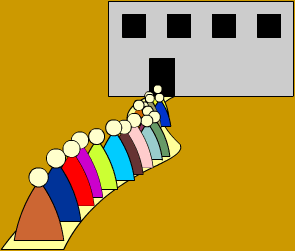Skip over navigation
Share some suggestions and then invite pupils to have a go, using whatever materials they would like.
You could use children in the class to act out the solution as a final check.
Could you use some equipment to help you? Or could you draw a picture?
How many students are in front of Urvisha?
Offer children some sort of equipment to represent the children so that they can try out their ideas.


Or search by topic
Number and algebra
Geometry and measure
Probability and statistics
Working mathematically
Advanced mathematics
For younger learners
Queue
Age 5 to 7
Challenge Level 





- Problem
- Getting Started
- Student Solutions
- Teachers' Resources
Queue
There are 25 students queuing in a straight line.
Julia is the 19th from the front, Urvisha is the 14th from the back.
How many students are there between Julia and Urvisha?

Why do this problem?
This problem provides an excellent opportunity to reinforce positional language.
Possible approach
Having introduced the problem, give pairs time to discuss how they could go about solving it.Share some suggestions and then invite pupils to have a go, using whatever materials they would like.
You could use children in the class to act out the solution as a final check.
Key questions
Could you use some equipment to help you? Or could you draw a picture?How many students are in front of Urvisha?
Possible support
Offer children some sort of equipment to represent the children so that they can try out their ideas.You may also like
Month Mania
Can you design a new shape for the twenty-eight squares and arrange the numbers in a logical way? What patterns do you notice?
Writing Digits
Lee was writing all the counting numbers from 1 to 20. She stopped for a rest after writing seventeen digits. What was the last number she wrote?

